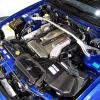Motorsport Tyres
Announcements
-
Similar Content
-
Latest Posts
-
Ha! well, there's your problem! Guess the last person in there didn't have great attention to detail....
-
It seems like you guys want to behave like rabid dogs, rather than gentlemen... Knowing one has jumped in on a fellow comrades near done deal, and sniped it at the last second, how can one sleep at night?
-
By DraftySquash · Posted
Good news!!! Changed the O ring today and I’ve got the “pssshhhh” back when I open the fuel cap 😂🙌🏼🙌🏼 It was 100% the O ring because that bloody thing was inside the fuel tank 😂😂😂😂😂 Fitting new fuel pump was a pain as always since the DW is a bit longer than stock. But she’s running!!! ❤️ -
PWM quite literally just chops the ful 12V voltage on and off at whatever duty cycle you're running it at. If you're running it 100%, then it is on full voltage all the time, same as if there was no PWM. If you run it at 50% duty cycle, it is only seeing the full 12V half of the time. This is broadly equivalent to running it at 6V. But the crucial difference is that motors (and a lot of other loads) don't like being powered at low volts. They will either fail to start rotating, or draw a shit ton of current, or other undesirable things. But if you give them the full volt, and then a short period of no volts, and then some more full volts, then the times when they are seeing power they are seeing all the voltage, and they are happy. But you get the performance out of them as if they were only seeing that fraction of the full voltage. It is not really easy to answer your question about what flow you will get out of it at 50% duty cycle. I can tell you that it is not as simple as you think. For a start, that 460 L/h pump is not going to flow 460 when you're on boost. When you're on boost you will be somewhere down the sloping part of that red line. If you have 15 psi of boost, then the pump can only deliver about 95 gal/h, which is <380L/h. So your simple 50% on 460 = 230 wasn't going to work anyway. But also, it won't deliver 50% of 380 either, because when you devolt or PWM trim th epower being fed to the pump, it is not able to deliver flow or pressure in the same way. 50% duty cycle will probably produce <50% of the full voltage flow. The way to find out what duty cycle you need to run it at at low load (ie, at idle) is to idle it and turn the DC down until you start to lose fuel pressure, then turn it back up above that with some extra for safety. And then you do the same thing at full load, in case it doesn't need anywhere near 100% DC. And if you're careful/caution/prudent, you will also do it at a couple of loads in between so you can shape the DC map against load. It might not be linear between the two end points.
-






Recommended Posts
Create an account or sign in to comment
You need to be a member in order to leave a comment
Create an account
Sign up for a new account in our community. It's easy!
Register a new accountSign in
Already have an account? Sign in here.
Sign In Now